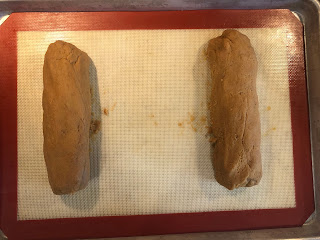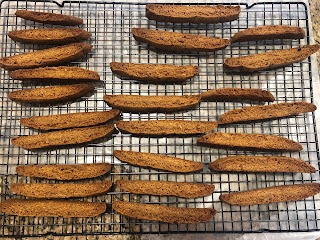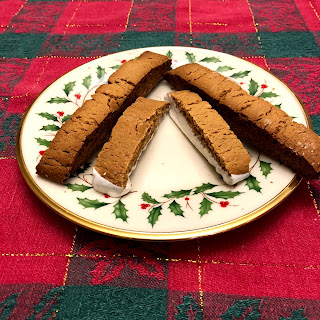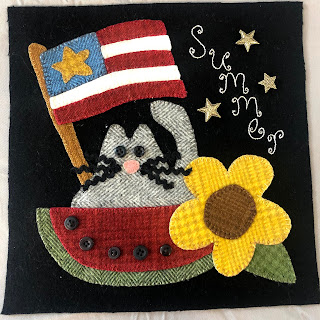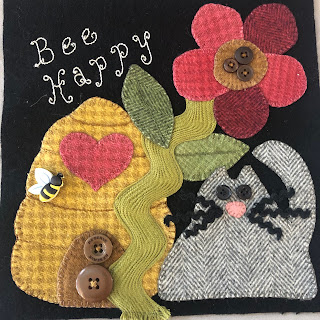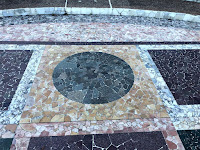As I shared in my most recent sewing-focused post, I've been enjoying the 2019 Wooly Block Adventure. I love seeing the participating shops' designs and the posts from individuals who are using the patterns to create their own blocks. I've also noticed from some of the posts, that some are new to wool appliqué. I thought it might be fun to use this post to highlight some of the techniques and processes involved in creating block. The block that I will be featuring is the "Chubby Kitty" block from Cotton Pickins' Quilts in Stanwood, Washington.
Before I get started, I will preface this entry by indicating that I will be featuring the techniques and processes that I find most successful. Another stitcher might disagree and demonstrate other preferred approaches. The take away point is that there really aren't a lot of rights and wrongs. Learn from different stitchers and adopt the styles that work best for you. I will also highlight some of the tools that I like to use. You may wish to consider adding some of these to your Christmas wish lists.
I will be illustrating appliqué using fusible web. Because you are applying your fusible web to the reverse side of your wool, the first thing you need to do is to determine whether the pattern pieces have been reversed. Typically, the author of the pattern will communicate whether the pieces have or have not been reversed. With this particular pattern, the pattern had not been reversed. This isn't a huge deal, it just means another quick step before you get started.
In this case, the pattern was drawn heavily enough so that I could just flip it over and trace the reverse side. To make the process easier, I used my light pad. A light pad isn't necessary, you can also use a window on a sunny day. Mine is a Litup brand light pad, and I've had it for several years. You can see that I used a Sharpie marker to do my tracing. Had I been working with smaller pieces, I would have used a smaller tip pen.

Now to look through the wool pieces and determine which piece of wool corresponds to which pattern pieces. Fortunately, this block has a relative few number of pieces, and they are fairly good sized so I had an easy time of it. Just the same, before I start fusing and cutting, I like to feel confident that I've matched up colors to pattern pieces.
So, now it's time to start tracing the pieces. Here are the tools that I need for this phase of the project. On the right is a mechanical pencil. I do prefer tracing in pencil, and I don't like having to hunt down a pencil sharpener. During back-to-school season a few months ago, I bought a couple of bags of these to keep myself tracing and fusing for years to come.
The white object is a roll of Soft Fuse which is the fusible web I prefer. It is distributed by Shades Textiles in Georgia. While many local quilt shops carry it, not all do. You can also order it from Amazon. I recommend buying 3 yards at a time. It's one of those supplies that lasts forever until it's gone. I also highly recommend saving "scraps" as you cut out pattern pieces. I put my scrap pieces in a tin and then use them first as I am about to trace a new project. More often than not, I can trace all of the small pattern pieces (e.g. leaves, stems, flower centers) using these scraps.
I really do use all three scissors. The black-handled one in the center is for cutting the fusible prior to fusing it to the wool. The ones on the right and left sides are Fiskars scissors. I use the smaller one for the little pieces and the big one for cutting the larger pieces once they have been fused.
Now for tracing and fusing. Trace the pieces onto the paper side of the fusible web. Cut the pieces out leaving about 1/8 - 1/4 inch from the drawn line. I will admit that most of mine are closer to 1/8 than 1/4. The next step is to fuse the cut pieces to your wool. Here's a little hint - think about which side you want facing up. Given that wool also has different textures and patterns, also think about whether the direction of the pattern matters or whether you want a given feature of the wool in a given location in your piece. Here's a quick look at my fused pieces.

A quick hint about tracing pieces - also keep in mind whether you need to account for overlapping pieces and extend the edges of some of the pieces so that they can be hidden by the overlapping piece. For example, I added about 3/16 inch to the lower border of my kitty to tuck it under the watermelon piece. Given that the stripes on the flag were so small, I did cut each to size and then took extra care to avoid any gaps when I was stitching. If you look closely, I also numbered the order of the stripes. The long ones were pretty obvious, but I wanted to be able to remember the sequence for the two small red ones. Here's a look at them all cut out and ready to be fused to the background.

Now it's time to peel off the paper and fuse the pieces to the background. Given that I am making an 8-inch block, I like to have my background cut to 8.5 inches to help me have a sense of where my actual boundaries are. I tend to start by fusing smaller to larger pieces - e.g. the star on the flag, center on the flower, nose on the cat. Of course, I won't be removing the paper on these larger pieces until after the smaller ones are fused down.
When it comes to fusing to the background, I tend to start by arranging the larger, focal pieces.
Then, I will add in the other pieces. You can see that I have committed to an approximate 1/4-inch border all the way around.
Once you are ready to commit to placement, go ahead and fuse in place with an iron set on wool and lots of steam.
Now, it's time to start stitching. Here are some of the supplies that I use. In recent years, I have had to swallow my pride and wear reading glasses for stitching. My bifocal contacts are great for reading, but I value the extra precision when sewing. On the left, you will see the size 24 chenille needles that I prefer for stitching. These are distributed through Primitive Gatherings and are also carried by many local quilt stores as well. They are a comfortable length for stitching and are nice and sharp for poking through layers of wool. The box below the pink floss contains appliqué pins. These are available at most local quilt shops. I like keeping them on hand in case I need a little extra reinforcement holding a piece in place until I can stitch it. The nice think about the pins is that they are quite short and the points tend not to get in the way as you are working.
Deciding on thread color - I use a combination of Valdani #12 threads and regular embroidery floss. I like the look of Valdani threads. At the same time, I don't have the budget for every possible color so I will also substitute 2 or 3 strands of embroidery floss. In general, you are looking for thread colors that will blend in with your wool. Most of the time, I just have to unwind the thread a little, place it on my wool and see what I think. Most of the time, you are better off erring on the side of just a little dark than going a little too light. Given the variation in the wool itself, overdyed threads with their variegated patterns can add interest to your piece. Most of my pieces will include both solid and overdyed thread. I've also completed pieces in which I was attempting to achieve contrast.

Now for stitching, I'm a fan of the traditional blanket stitch for going around the edges. With the larger pieces included in this block, the blanket stitch is an ideal choice. When working with extra small pieces, other stitches such as a simple whip stitch might be appropriate. A series of cross stitches might be appropriate to hold a narrow stem in place.
Now that the blanket stitching is done, it's time to add the word "Summer." My preference for words is to trace them onto tissue paper, pin the paper down to the background, and outline stitch over the top of the traced letters. The picture on the left is the traced letters. The picture on the right illustrates the stitched over letters.
When the stitching is complete, you tear away the tissue paper. I will admit that I often need to take my needle to help pick the residual paper from underneath some of the stitches. I am also someone who is not at all comfortable drawing the letters freehand so I bear with the added nuisance for letters that look nice when I am finished.
Now, for the final touches - stitch on the rickrack whiskers. The pattern had suggested to cut the shorter whiskers 1.5 inches long and the longer whiskers 2 inches long. I ended up trimming mine down to 1 inch and 1.5 inches respectively. I'm not a fan of sewing narrow rickrack down - especially when it's more or less black on black. Let's just say I used my machine, did the best I could, and secured the rickrack. The final step is sewing the buttons, and here is another look at the completed block.
I also finished the block from last year. I had completed everything but the whiskers. I figured that while I was sewing down one set of whiskers, I might as well complete a second set.
While I was ordering this year's block, I was also taken in by the winter and fall blocks from previous years. I will definitely have plenty to keep me busy this winter. We had some record snowfall in the Intermountain West these past few days so this could turn out to be a very good winter for completing wooly projects.
As we shift our focus from Thanksgiving to Advent, I wish you all a very blessed season. From the time I was little, I've enjoyed December's Sunday School lessons beginning with the messages of the prophets concluding with Jesus' birth in Bethlehem. The theme of the first Sunday of Advent is hope. I will conclude this post with the message of hope spoken by the prophet Isaiah.
Then a shoot will spring from the stem of Jesse, and a branch from his roots will bear fruit. And the Spirit of the Lord will rest on him, the spirit of wisdom and understanding, the spirit of counsel and strength, the spirit of knowledge and the fear of the Lord, and he will not judge by what His eyes see, not make a decision by what His eyes hear, but with righteousness He will judge the poor, and decide with fairness for the afflicted of the earth. Isaiah 11:1-4







